Horse-Drawn Omnibuses
In the period before the advent of trams in Glasgow, the most popular form of public transport was the horse-drawn omnibus, but the ride over the cobblestones was bumpy. The idea of running the carriage wheels in rails to achieve greater comfort was therefore very appealing. For trams to operate in Glasgow, the Town Council had to obtain permission from the Westminster Parliament and this was granted in August 1870 with the passage of the Glasgow Street Tramways Act. Within two years, the Town Council had the first tram lines laid along a 21⁄2-mile stretch from St. George’s Cross to Eglinton Toll (via New City Road, Cambridge Street, Sauchiehall Street, Renfield Street, Union Street, Jamaica Street, Glasgow Bridge, Bridge Street, and Eglinton Street).
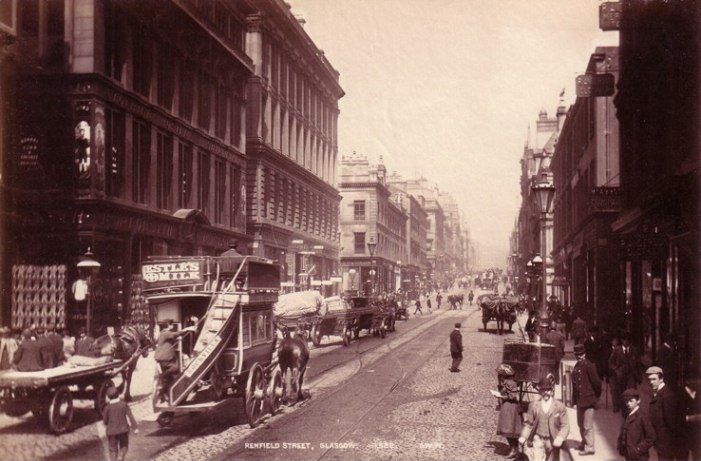
This view of Renfield Street was probably taken in the early 1890’s by an associate of the renowned photographer George Washington Wilson. The tram lines in Renfield Street had been laid by 19 August, 1872 as part of Glasgow’s first horse-drawn tram route between St. George’s Cross and Eglinton Toll that passed through Renfield Street. The public transport vehicle in the foreground is a horse-drawn omnibus and is probably “three-in-hand”, hauled by three horses in line abreast. In spite of having suspension, the ride in these carriages over the cobblestones would not have been as comfortable as that experienced in trams running on track, and the latter would eventually completely displace the horse-drawn buses. The upper deck on these omnibuses was not enclosed so the passengers were fully exposed to the elements and this level of exposure would continue through the horse-drawn trams and into the first generation of electric trams. ( Original albumen photograph )
It should be noticed that although the tram lines are already in place, there are no trams in view. On the left is the building where R. W. Forsyth started in business as a hosier, glover and shirt maker in 1872. He would open a second branch on the corner of Jamaica Street and Howard Street around 1891 and move to newly-built premises on the corner of Renfield Street and Gordon Street in 1898. Stuart Cranston would open a tearoom in R. W. Forsyth’s vacated Renfield Street premises in September of that year. This view shows the two distinct types of gas lamp present on Glasgow’s principal streets at that time; tall slender lamp-posts well-spaced apart and fitted with hexagonal lanterns, and shorter lamps, more frequently sited and with four-sided lanterns.
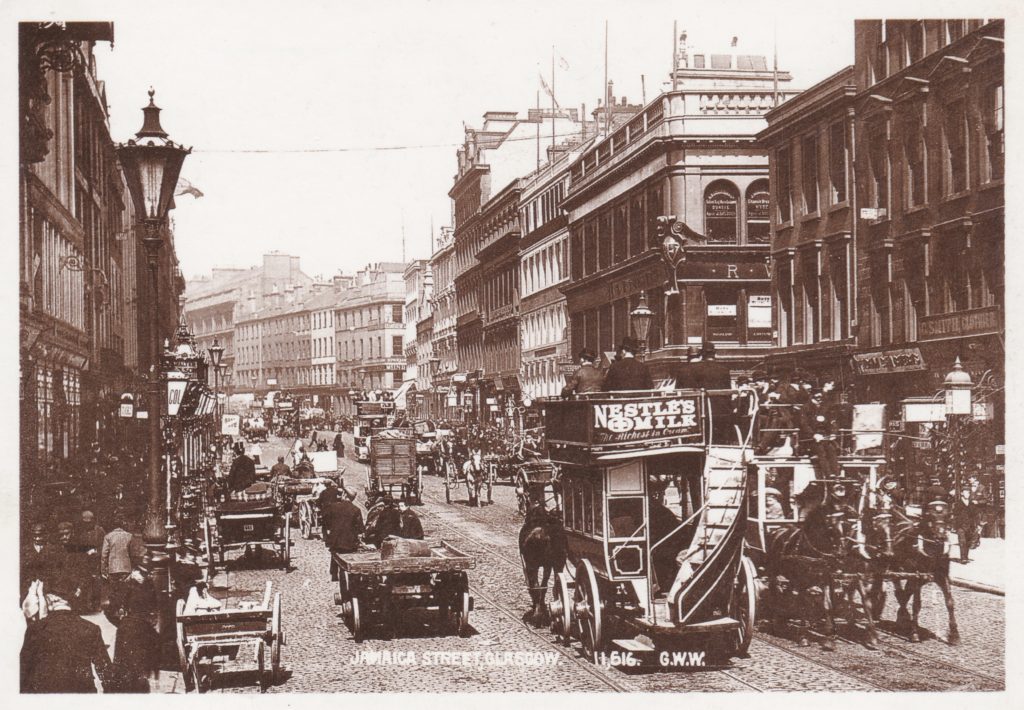
In this Jamaica Street scene, there are two omnibuses in the foreground, both three-in-hand, and they appear to be well-maintained. There is a branch of R. W. Forsyth in the photograph, just visible above the omnibuses, on the corner of Jamaica Street and Howard Street. The first reference to Forsyth’s at this location is in the 1892 – 1893 Post Office Annual Glasgow Directory, so the Company trams would still have been running at that time and there appears to be a Company tram in this scene, further up Jamaica Street. This would therefore date the photograph to 1892-1894, assuming that there was no delay entering Forsyth’s Jamaica Street address into the Post Office Directory.
Horse-Drawn Company Trams
The Act prohibited the Council from directly operating the tram service for the first 21 years and instead stipulated that a private company be engaged. Andrew Menzies, a Glasgow omnibus pioneer, and his company, the Glasgow Tram and Omnibus Company (hereafter referred to as “the Company”), were hired and the service between St. George’s Cross and Eglinton Toll came into operation on 19 August, 1872. As expected, the change from horse-drawn omnibuses to horse-drawn trams resulted in a significant improvement in passenger comfort, and it was also easier for the horses to pull a carriage on rails than over cobblestones. The popularity of the new tram service led to a rapid expansion of the system and new routes were established between Whiteinch and Bridgeton Cross, Bridgeton Cross and Candleriggs, St. Vincent Street and Dennistoun, Bridge Street and Paisley Road Toll, and Eglinton Toll and Crosshill.
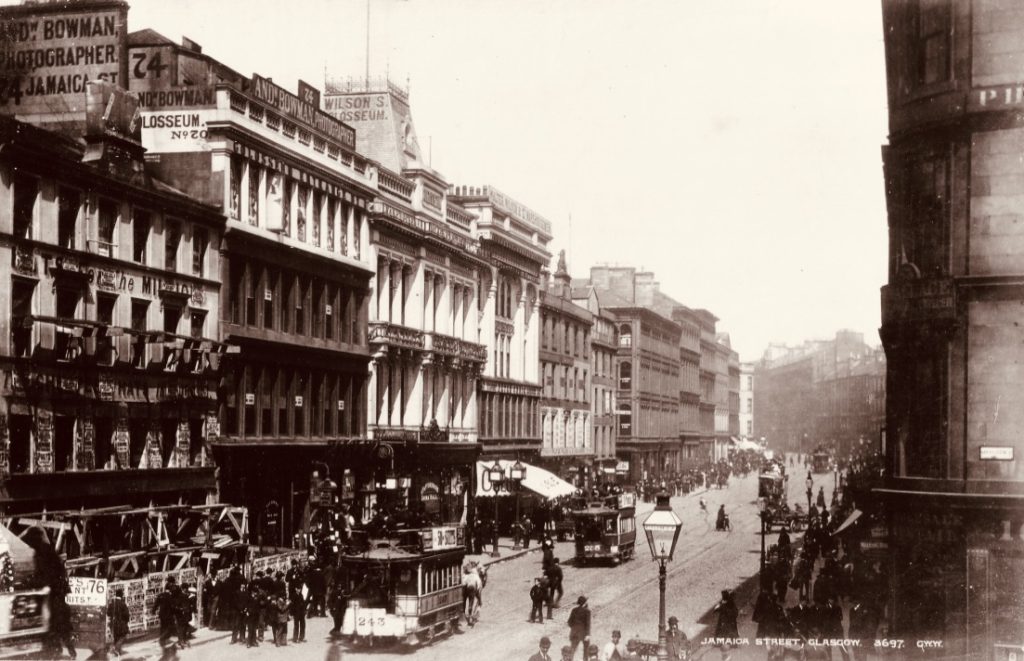
Horse-drawn trams of the Glasgow Tramway & Omnibus Company were heading northbound when George Washington Wilson took this photo overlooking Jamaica Street. The Company cars, as they were called, first entered service on August 19, 1872 on track owned by Glasgow Corporation. In 1875, route colour coding was introduced and this is present on the trams seen here. They are both Type 1B cars, numbered 243 and 255, with eight windows each side, and were modified versions of the original batch of heavy trams ordered by the Glasgow Tramway & Omnibus Company from the Tramway Car & Works Co. Ltd. of Greenwich, London. Each of these cars weighed two tons empty and once all 40 seats were occupied and standing passengers were also present, the total weight could be as much as 5 tons, a considerable load for a pair of horses to pull. ( Original albumen photograph )
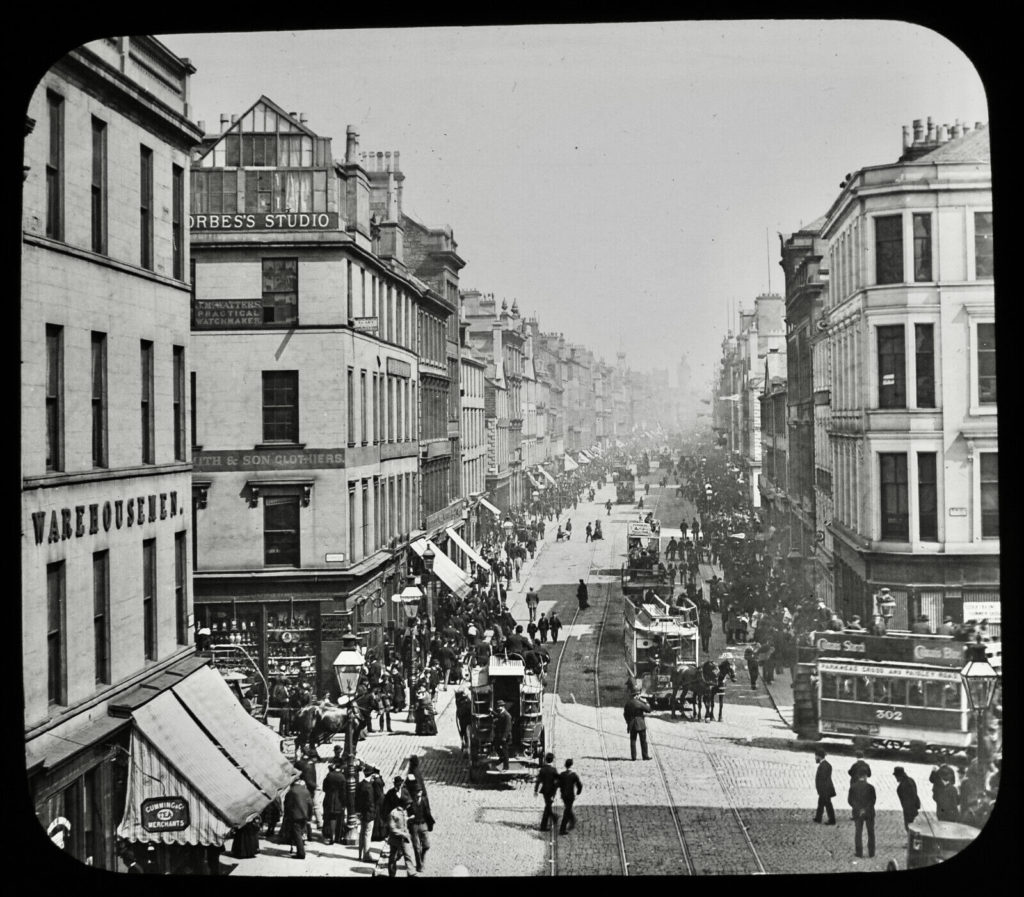
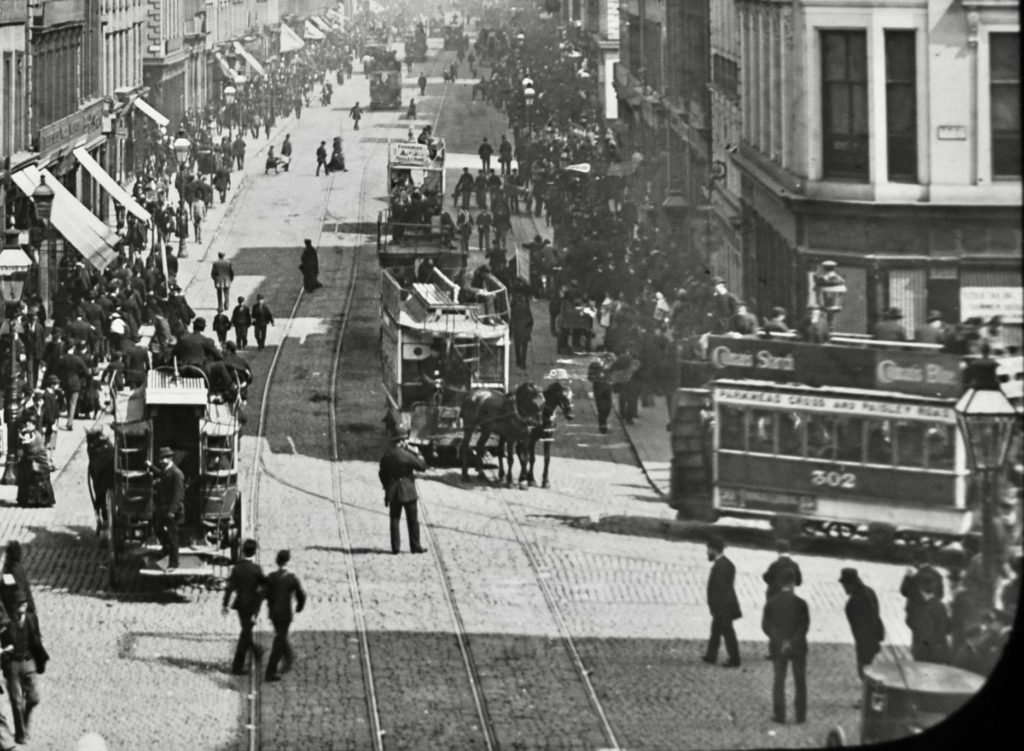
Company trams at the intersection of Argyle Street with Union Street and Jamaica Street are seen here in the late 1870’s. Car 302 en route from Parkhead Cross to Paisley Road is turning left into Jamaica Street and it is followed by Car 211, both of which have been modified from the early batch of Type 1 heavy Greenwich-built cars. Car 211 still retains the iron rung stairs fitted outside the dash, classifying it as a Type 1D tram while Car 302 with rebuilt stairs may be Type 1E or 1F. The vehicle on the left of the picture is a horse-drawn omnibus. All of the vehicles shown have knife board ( back-to-back ) seating on their upper deck. (Scanned from a George Washington Wilson lantern slide in the archive.)
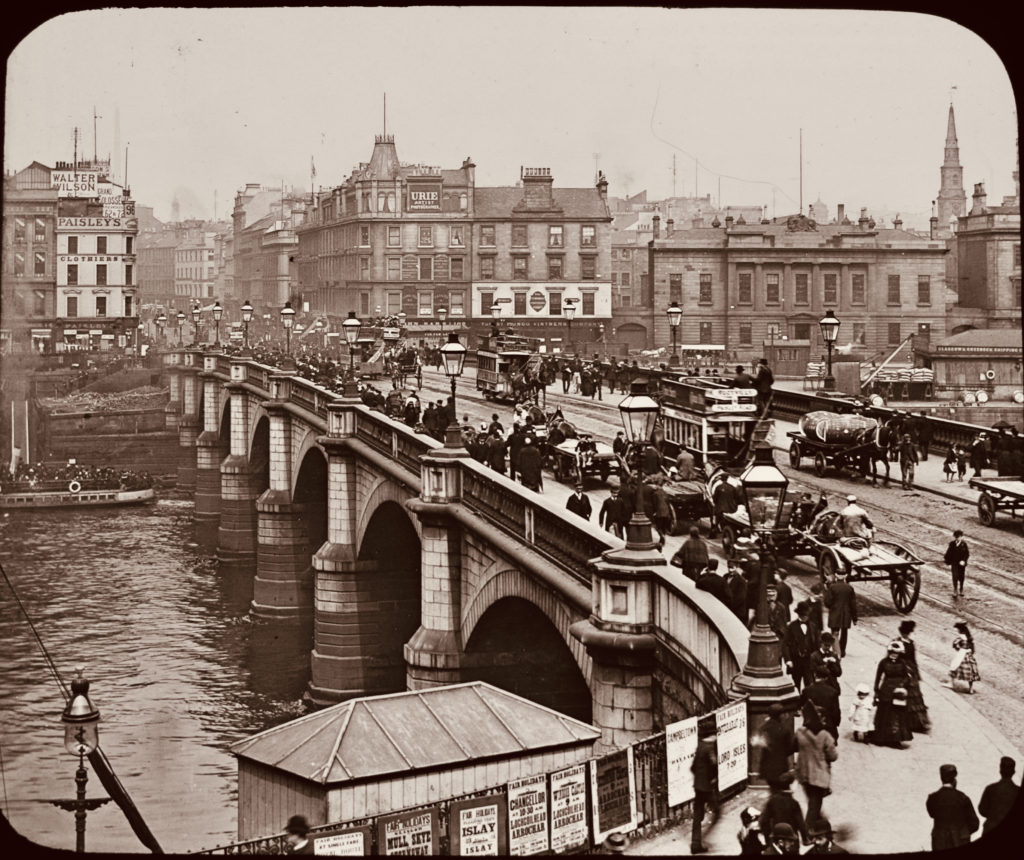
Company cars are seen here on Glasgow Bridge, also known as the Broomielaw Bridge, most probably in the late 1870’s/early 1880’s. The structure of St. Enoch Station and Hotel can be seen in the margin to the right of St. Enoch Church spire, the station having been opened in 1876 and the hotel in 1879. The tram in the foreground, en route from Paisley Road to Rockvilla, has 7 rectangular windows visible, so is a John Stephenson New York design vehicle and this, together with the knife board seating on the upper deck, would classify it as a Type IIA car. The fresh paint suggests that it recently entered service. The car approaching, heading for Paisley Road, is of a similar type, only more weathered. (Scanned from a George Washington Wilson lantern slide in the archive.)
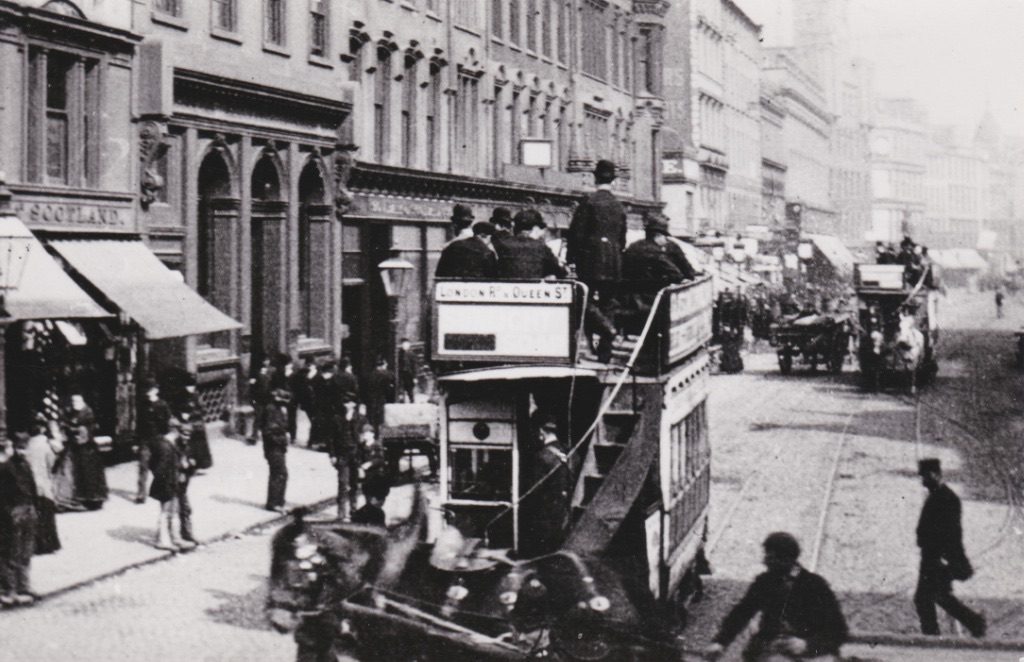
Seen here in the Trongate is a Type IIB Company horse tram with 7 windows on each side and garden-type seating upstairs instead of knife board. This vehicle was based upon a design by John Stephenson of New York and was much lighter than the Type I cars and therefore much easier for the horses to haul. This tram is on the eastbound track and working the short route between Queen Street and London Road. In the foreground, a horse and cart is seen passing behind the tram. ( Original photograph )
Depots and Stables for the Company Trams
The principal depots and stables for the Company trams and horses were located in Cambridge Street near Sauchiehall Street, David Street near Crownpoint Street in Calton, Tobago Street near its junction with Great Hamilton Street ( later renamed London Road ), and Nelson Street near Centre Street in the Gorbals. Crownpoint Street, which runs through the area south of the Gallowgate, was also the location for the Company’s main Crownpoint Works which opened in 1877 and where the tramcars would ultimately be manufactured and repaired.
Horse-Drawn Glasgow Corporation Trams
The Glasgow Tramway and Omnibus Company operated the tram service and subsequent extensions to the system until 30 June 1894. Glasgow Town Council, which had now become Glasgow Corporation, had opted not to renew the Company’s operating lease and instead commenced their own municipal tram service, Glasgow Corporation Tramways, on 1 July 1894. They inherited a system that was carrying 54 million passengers a year.
Glasgow thus became the first city in Great Britain to own and operate its public transport system. Upset at not having their lease renewed, Andrew Menzies’ Company refused to sell its assets to Glasgow Corporation and so the Tramways Department had to start fresh with new staff, horses, and their own trams while the Company set up in competition. The Glasgow public preferred the Corporation’s new trams to the old used Company ones and the Corporation also had stronger finances. It was able to reduce fares by up to 50% and so the competing Glasgow Tramway and Omnibus Company bowed out. In its first full year of operation, Glasgow Corporation Tramways carried over 57 million passengers collectively more than 5 million miles. And nothing succeeds like success. Profits increased and further investments were made in improving efficiency and expanding the network. By the turn of the century, Glasgow Corporation Tramways was carrying one-fifth of the total number of passengers conveyed by all the tramways of England and Wales.
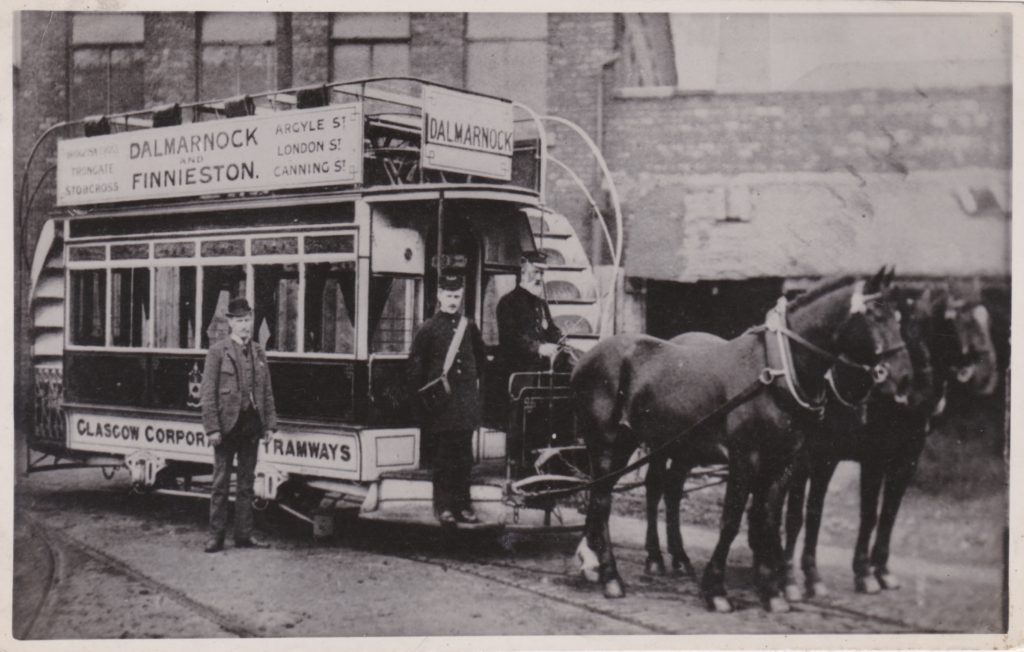
A brand new Glasgow Corporation horse-drawn tram is about to enter service on the Dalmarnock and Finnieston route. The driver and the conductor are both in their new uniforms and the man in the suit is probably the depot manager. This East – West route would be predominantly flat so that would be good news for the horses. One of the streets along the route is listed as London St. and this would subsequently be renamed London Road. (Photograph by Glasgow Corporation Tramways.)
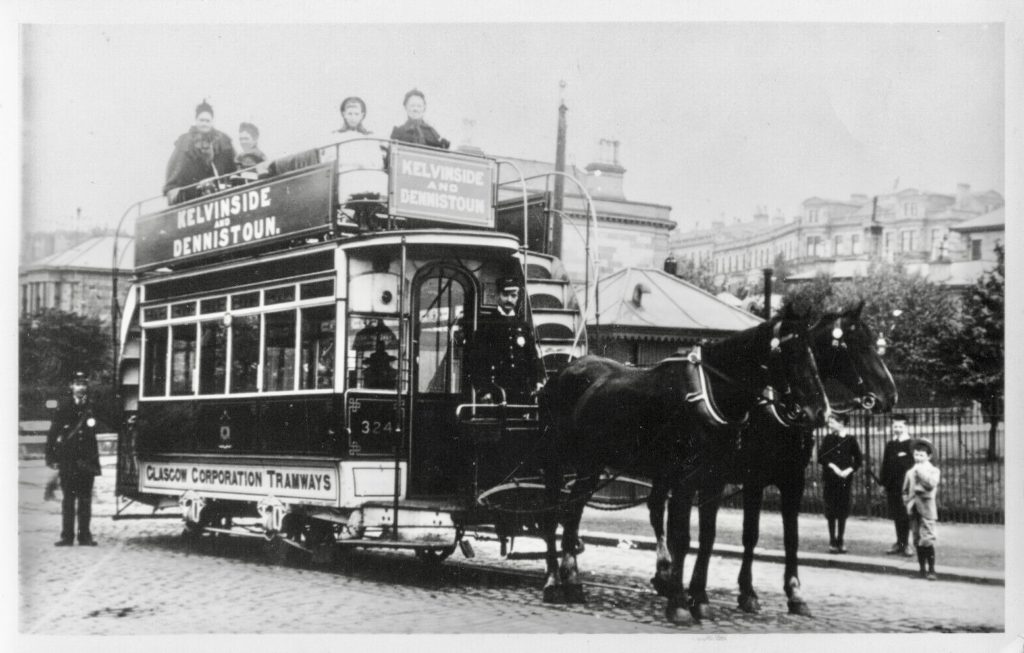
Here, Glasgow Corporation horse car number 324 is seen together with its driver, conductor, and a fine pair of black horses at the Kelvinside terminus of the service to Dennistoun. It appears that most of the passengers have moved upstairs so they can be included in this official photograph by Glasgow Corporation Tramways.
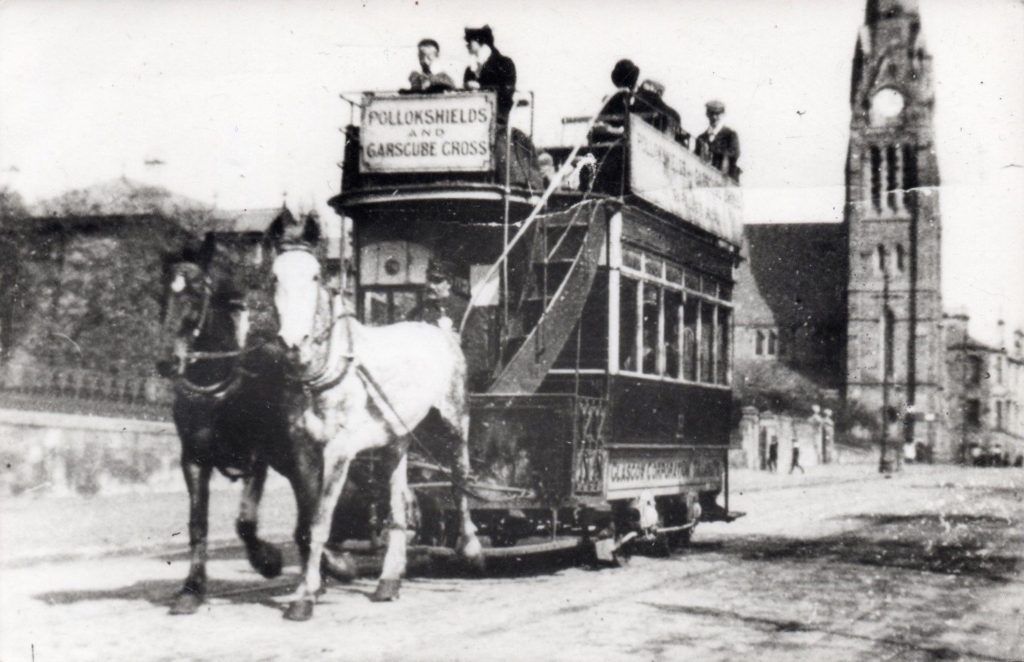
A Corporation horse-drawn tram is seen here on Albert Drive in the late 1890’s with Pollokshields Parish Church in the background. The tram is almost at its southern terminus and the horses will be glad of a rest. They have come a long way from Garscube Cross, known locally as the Round Toll. On the return journey, the horses will encounter a steep incline on Renfield Street as they head up to Cowcaddens, and then there is a further incline on Garscube Road on the approach to the Round Toll. Trace horses would have been used to reinforce the regular horses on steep inclines. The tram carriage itself has six windows each side and 160 of these carriages were subsequently converted into electric trams. I am grateful to Hugh McAulay of the Scottish Tramway and Transport Society for supplying some of this information. ( Photograph by Glasgow Corporation Tramways.)
Electrification of the Tramway System
The Victorian era saw huge improvements in technology including the harnessing of steam and electric power for mechanization and propulsion. In the United States, an increasing number of tramway systems were powered by electricity supplied by overhead wires, so Glasgow decided to do the same and on 13 October, 1898 began with a test route from Mitchell Street to Springburn, including the steep incline of West Nile Street which was certainly a challenge for horse – drawn trams but proved no problem for the electric trolleys. Glasgow’s first 20 electric tramcars were of an American-inspired design, single-deck and with a central entrance. They would become known as “room and kitchen” cars, one of which has been restored and is now on display at the Riverside Museum. It was the success of this test route that led to a rapid electrification of the system, with an eye to having as much work completed in time for Glasgow’s planned International Exhibition in 1901.
The rush was on to order new tramcars and the bulk of the manufacture was done by Glasgow’s own Coplawhill Works on Albert Drive in Pollokshields. In addition to building new cars, 160 of the best horse-tram car bodies were converted to electric cars at the works. However, there was more to electrification of the tramway than ordering new trams. The existing tracks had to be replaced with stronger rails, capable of handling heavier loads, and large numbers of ornate metal standards were ordered and erected to provide support for the overhead wiring. This entire process would take four years, although a substantial amount of work was completed in time for the 1901 Exhibition, when the new system would be showcased.
Glasgow’s New Electric Trams
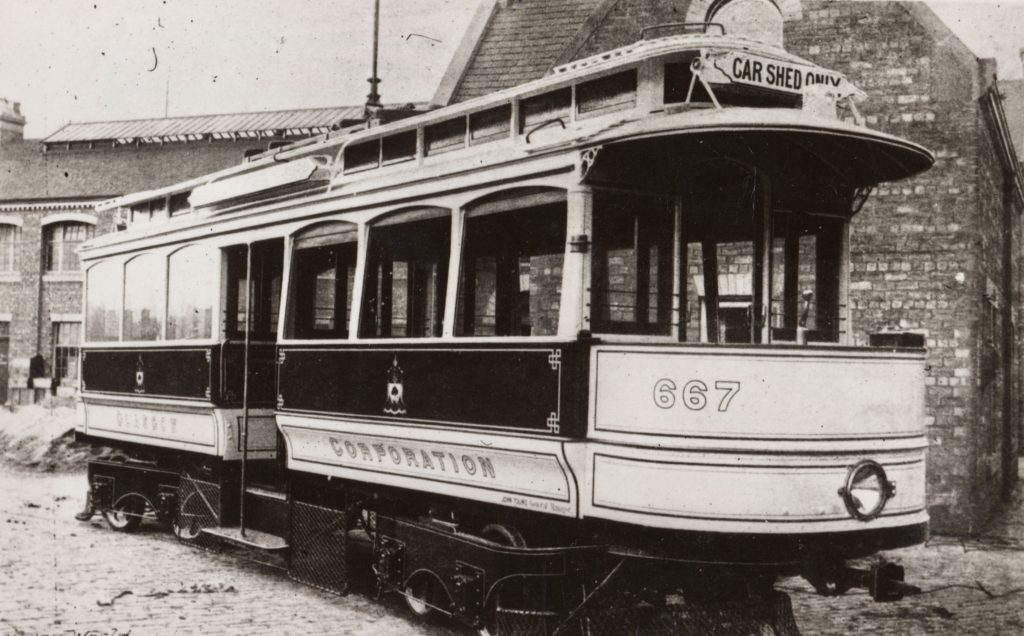
Car number 667 is one of 21 single-deck tramcars that were purpose-built at Coplawhill Works to launch Glasgow Corporation’s electric tram service between Michell Street and Springburn, a route previously considered too steep for horse-drawn operation. The design of these trams was based upon American street cars that had a central entrance and exit. In Glasgow’s case, one compartment of the tram was glazed and the other half had no windows at all, but instead roller blinds were installed to protect the passengers from Glasgow’s famously inclement weather.
Nicknamed “Room and Kitchen” after the tenement dwellings, the cars entered service in 1898 but they were not a success. They had a habit of derailing on curves, so much so that a re-railing squad was on hand to intervene at known trouble spots. Eventually, the operation of these trams was restricted to the straightest route on the network, running between Clydebank and London Road. They were progressively withdrawn from service from 1905 and all were in storage by 1911, with one exception.
Car number 672 was fitted with four motors instead of two so that it could be used to carry heavy electrical equipment for testing purposes. This added weight solved the derailing problem and the car survived long enough to be restored back to its original appearance and is now preserved at the Riverside Museum. Many thanks to Hugh MacAulay of the Scottish Tramway and Transport Society for providing some of this information. (Photograph by Glasgow Corporation Tramways, dated 1898.)
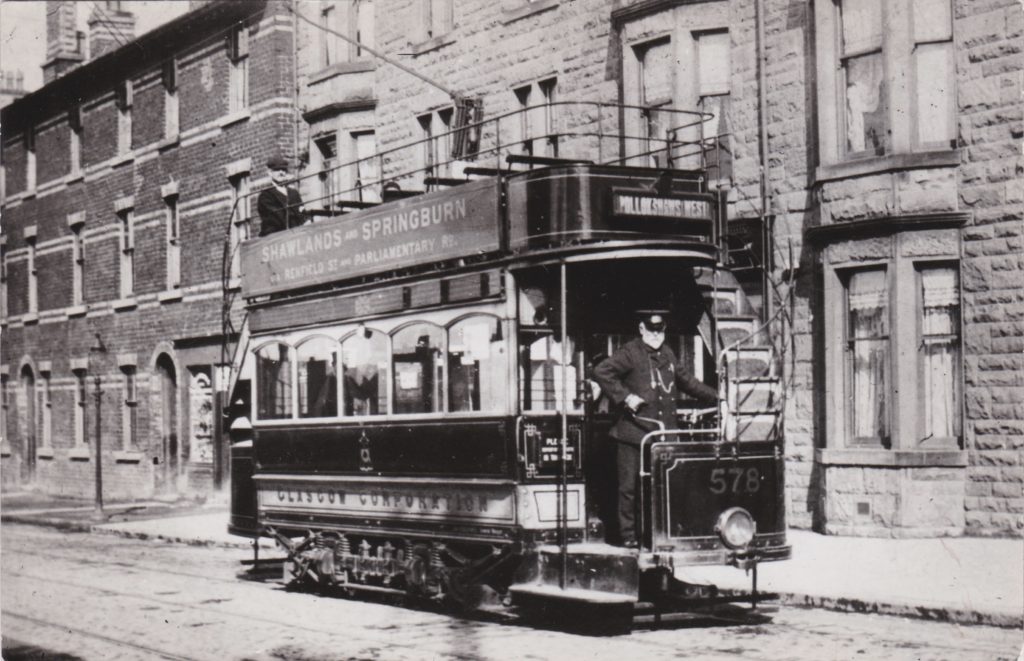
One of Glasgow Corporation’s new purpose-built electric trams with five arched windows on each side is seen outside Keppochhill Road Depot in Springburn, about to set off for Pollokshaws West. Red route ‘R’ was the original electric tram route which reached Pollokshaws West by 14th June 1902 and was extended to Rouken Glen on 30th April 1909. The tenements in the background had been recently built and the original power station for the electric trams was located alongside the depot. This source would close down once the new Corporation – owned Pinkston Power Station was fully operational in 1902. Again, many thanks to Hugh MacAulay of the Scottish Tramway and Transport Society for providing some of this information. (Photograph by Glasgow Corporation Tramways.)
This design of electric tramcar was to provide the foundation for the greatest number of Glasgow’s trams which would become known as the Standards. There would be several modifications along the way and this first stage would later be described as Phase I. The next stage in the evolution of the Standard Tram would be the addition of a roof over the upper deck, resulting in Phase II. Phase III was achieved by the addition of vestibules, windows protecting the driver ( motorman/woman ) from the elements. And finally, the enclosure of the open balconies on the upper deck would result in Phase IV of the design. Representatives of each Phase of the Standard Tramcar will be illustrated.
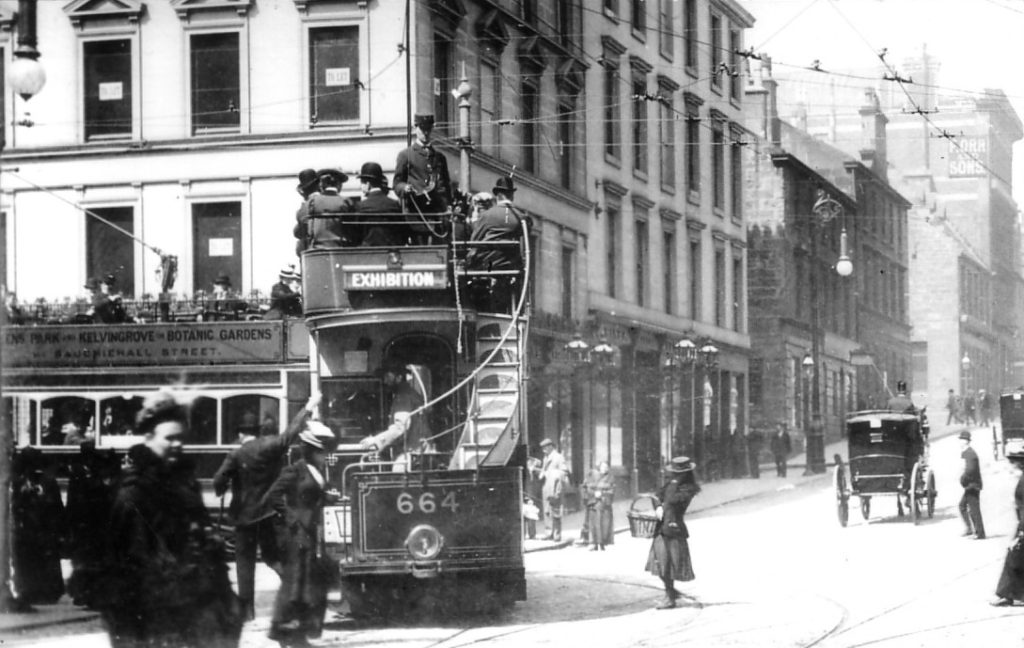
A tramcar heading for the International Exhibition at Kelvingrove Park is just turning into Sauchiehall Street from Renfield Street in this Summer 1901 scene. The city where the Industrial Revolution is in full sway is now hosting its second great International Exhibition and the recent electrification of the tramway system serves to further showcase Glasgow’s achievements. Both of the trams in this picture are purpose-built Phase I electric cars, resplendent in their colourful livery of cadmium orange side panels, ivory trim, and plum/brown for the dashes. Each route is colour-coded and car 664 in the foreground would have chrome yellow panels above the windows, bearing route information, probably similar to that of the car in the background. Note that the conductor on the top deck has a cap similar to that of a gendarme and the driver’s ( motorman’s ) cap would have been the same. ( Original photograph )
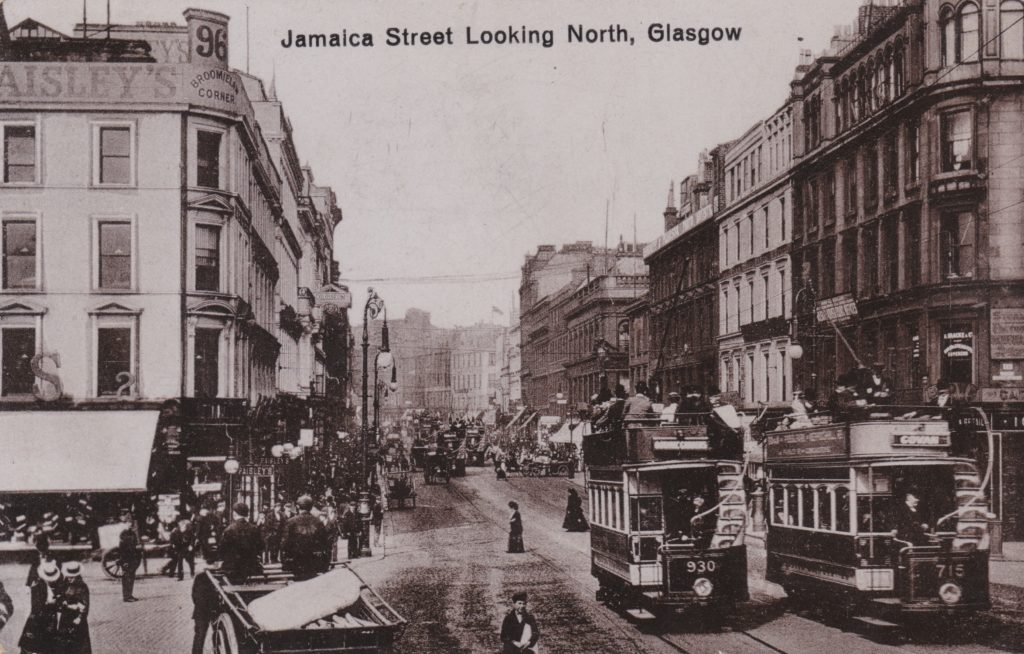
Two purpose-built Phase I electric trams, newly in service, are passing each other heading in opposite directions at the foot of Jamaica Street in this very early 20th Century view. This particular location was part of the first tramway to be built in Glasgow, running between St. George’s Cross and Eglinton Toll. To the left in this scene is the Broomielaw and to the right, Great Clyde Street.
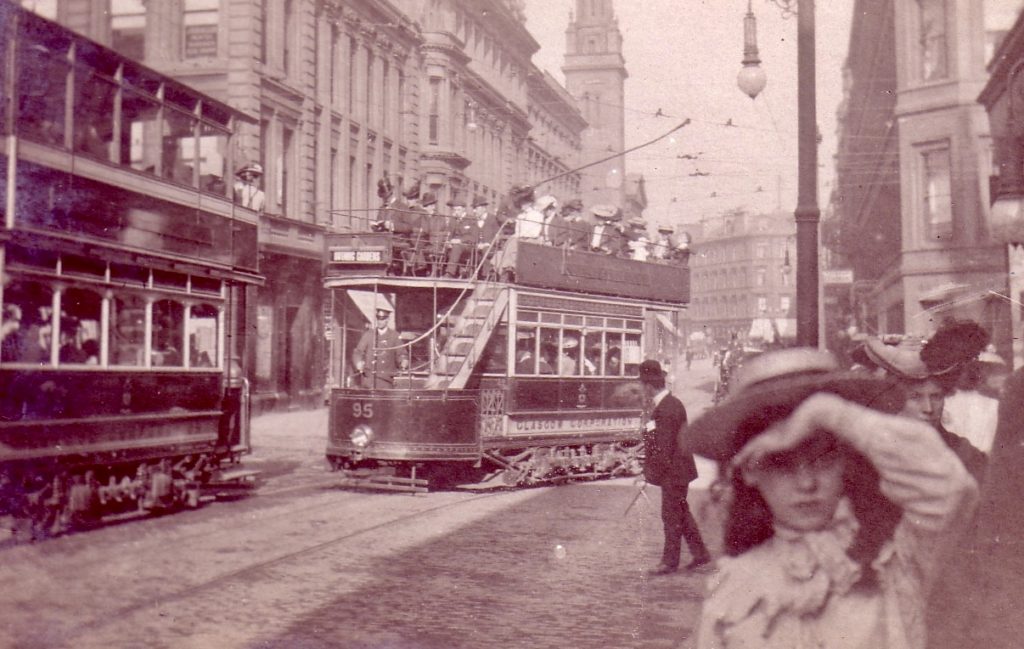
A young girl is focussed on the photographer in this view, circa 1910, looking east along Sauchiehall Street towards Armstrong’s Hotel and Parliamentary Road in the distance. The Central Halls Building, housing the Royalty Theatre, is on the left of the picture and the magnificent tower of St. John’s Methodist Church can be seen further along the street. A crowded tramcar bound for the Botanic Gardens is coming round the corner from Renfield Street while a smartly dressed man waits beside the kerb. The tram has six rectangular windows on each side, indicating that it was a former horse-drawn tramcar that had been subsequently converted into an electric vehicle. These cars fulfilled a useful function in meeting the urgent demand for trams for the newly electrified tramway, and they would eventually be replaced by purpose-built electric cars in the years following the Great War. The motorman here is wearing a new style of peaked cap, so the uniform had undergone a change sometime between 1901 and 1910.
The other tramcar in this scene, a purpose-build electric tram, identified by the five arched windows on the lower level, has had its top deck covered, making it now a Phase II tramcar. ( Original photograph )
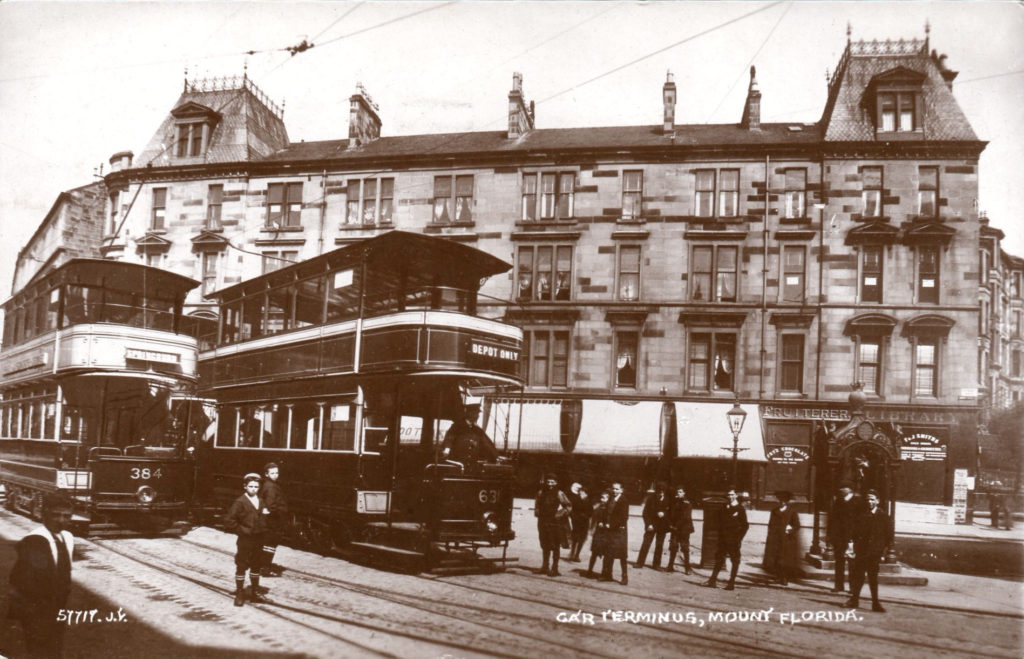
Two Phase II trams are seen here in Clincart Road, the Mount Florida terminus, in 1907. The tram on the right is just pulling in and looks like it may be subsequently bound for Langside Depot on nearby Battlefield Road. The fine tenement building on Cathcart Road is still present today but with shorter chimneys and new windows. On the far right, Stanmore Road leads up the hill. ( Original postcard published by J. Valentine & Co., Dundee. )
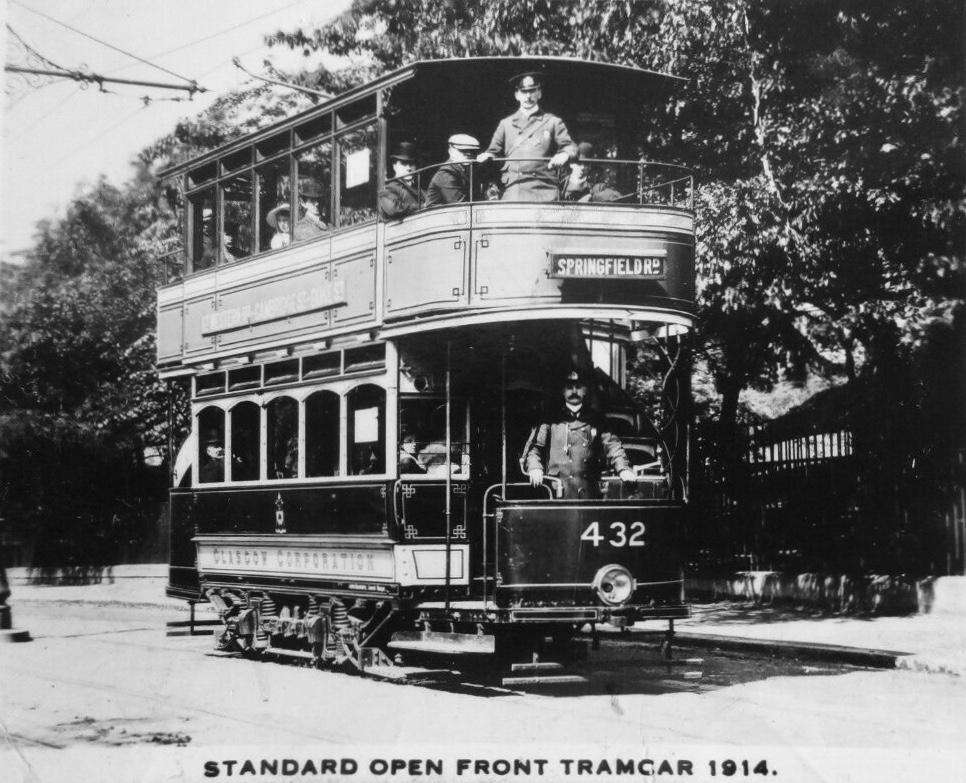
Car number 432, together with its crew and passengers, are seen here in Great Western Road on a sunny day in 1914. The tram is in Phase II condition, a roof having been added, enclosing most of the upper deck except for the balconies. The motorman’s compartment below is still open to the elements. The tram is about to set off for Springfield Road via Cambridge Street and Duke Street, as indicated on the side panel. Events in Europe would soon overshadow the tranquility of scenes like this and one can only wonder what happened to the crew in the Great War which ensued. ( Original photograph )
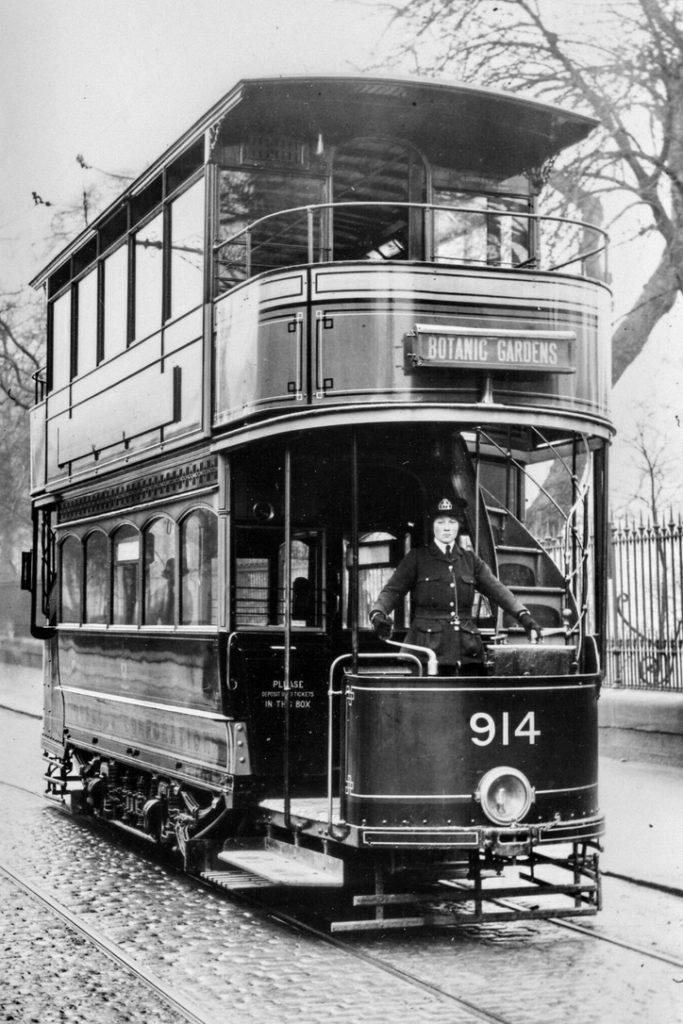
A motorwoman is now in charge of Phase II Car 914 at the Botanic Gardens terminus. At the beginning of the Great War in August 1914, Glasgow Magistrates asked the Corporation employees to form two battalions to help in the war effort and many of those who volunteered were Tramway motormen and conductors. They became the 15th Battalion of the Highland Light Infantry, known as the Glasgow Tramways Battalion. In order to keep the trams running in their absence, the Corporation encouraged women to train as drivers and conductresses, a practice that continued after the war and up until 1 September, 1962, the last day of tram operation for the public.
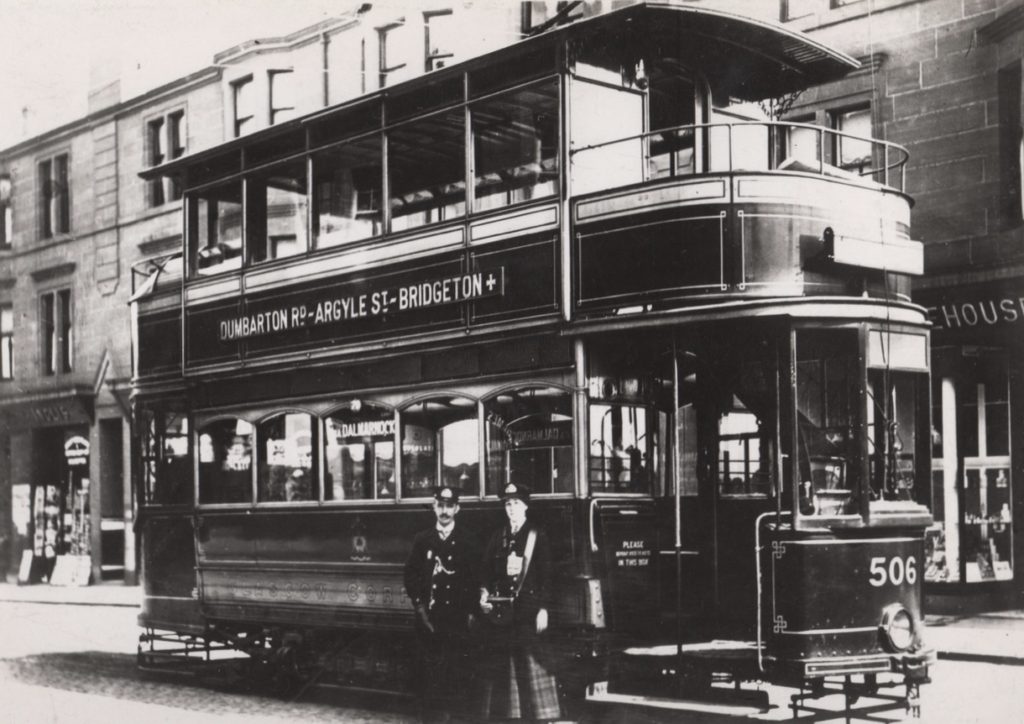
Like Car number 432, Car 506 was also photographed in 1914 but there are two notable differences, apart from the absence of passengers. The driver’s compartment in 506 has been enclosed by a vestibule so that the motorman is no longer exposed to wind, dust and driving rain. The addition of vestibules at both ends of the tram now elevated this car to Phase III status. The second significant difference from the Car 432 photograph is the presence of a conductress. ( Glasgow Corporation Tramways original photograph )
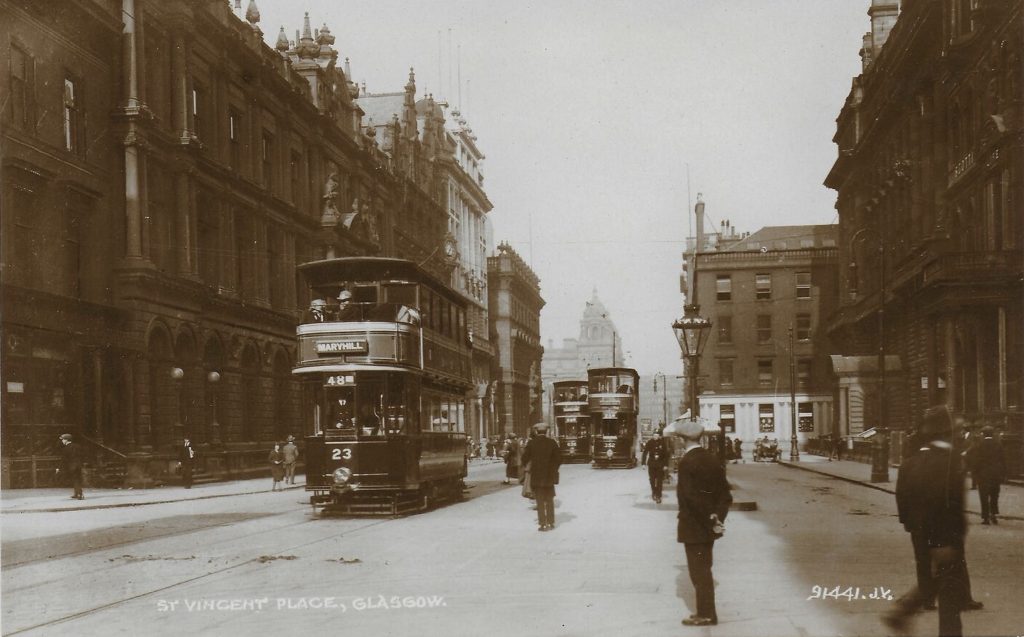
Three Phase III trams in immaculate condition are seen here in this classic photo of St. Vincent Place taken in 1924. The leading car, No. 23, was relatively new, having been completed in May 1922 as a blue route car that would later be changed to red by May 1929. The head codes at the top of the vestibules had been recently introduced and became immediately unpopular with the crews because they had to be changed at the end of every trip and it did not help that the handle to turn them was difficult to access and slow to operate.
The orthochromatic film that was used at this time distorted the various route colors. For example, red and yellow came out looking black in the photos whereas the blue route colour appeared lighter. White was probably the exception as it appeared white in the photographs also. I am grateful to Hugh McAulay and Ian Stewart of the Scottish Tramway and Transport Society for providing information regarding this scene. ( Postcard published by J. Valentine & Co., Dundee. )
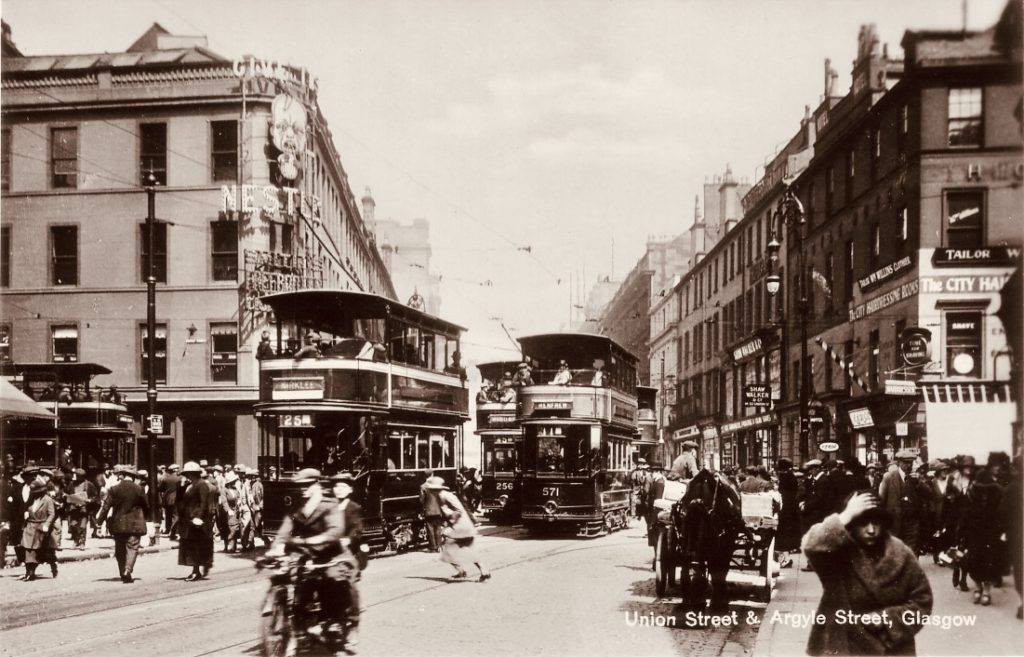
There is plenty of action in this “Roaring Twenties” scene downtown at the intersection of Argyle Street with the junction of Jamaica Street and Union Street. Tramcars are clattering across the intersection in both directions and a woman is racing across the path of approaching car 571 bound for Renfrew. The passengers seated in the open balconies of these tramcars would have a grandstand view of the action. All of the trams here are in Phase III condition with vestibules protecting the drivers while the balconies upstairs are not enclosed. I have seen a used example of this postcard dated 10 June, 1925, so the photograph may have been taken in 1924 or early 1925. ( Anonymous publisher )
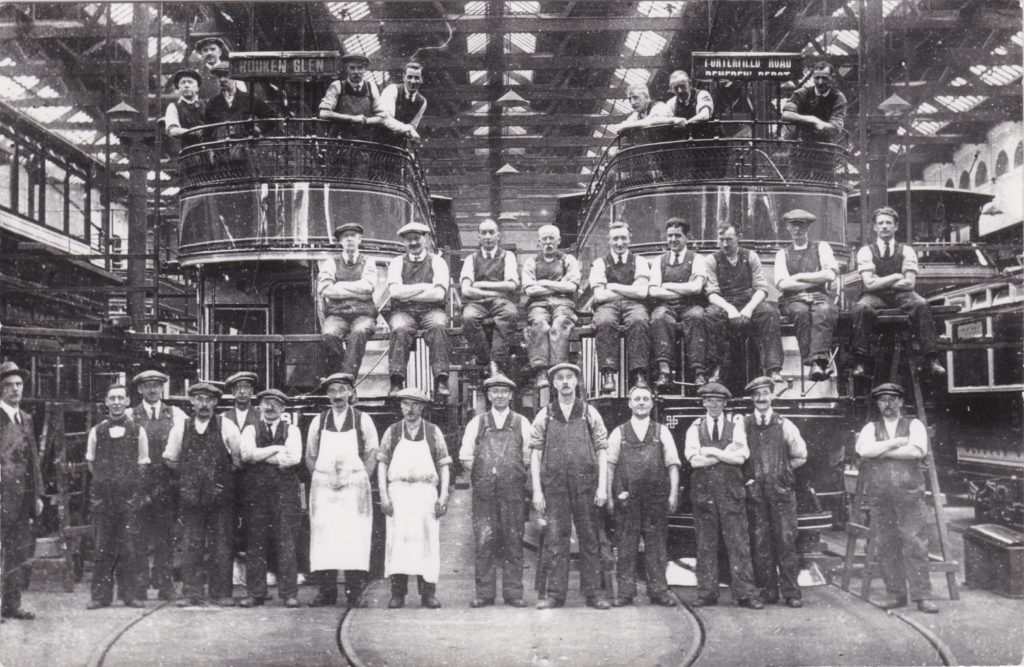
Here, the men of the Coplawhill Works Paint Shop are photographed with a pair of newly refurbished ex-Airdrie & Coatbridge Tramways Company trams in a scene dated 7th June, 1926. These trams would first have been through the main works for any repairs and alterations before coming into the Paint Shop to be repainted into the Glasgow Corporation Tramways livery. The Airdrie & Coatbridge Tramways Company was acquired by Glasgow Corporation on January 1, 1922 and was connected to the Glasgow system by a lengthy section of roadside reserved track between Baillieston and Langloan in Coatbridge.
The trams shown here are now bearing destinations which apply to the Paisley area of operation. Rouken Glen was a long route from Paisley, through Barrhead, and then to Spiersbridge, which was a short distance from Rouken Glen Park where Glasgow trams ran a circular route from the city. I would like to thank Hugh MacAulay of the Scottish Tramway and Transport Society for providing this information. ( Original photograph, Glasgow Corporation Tramways )
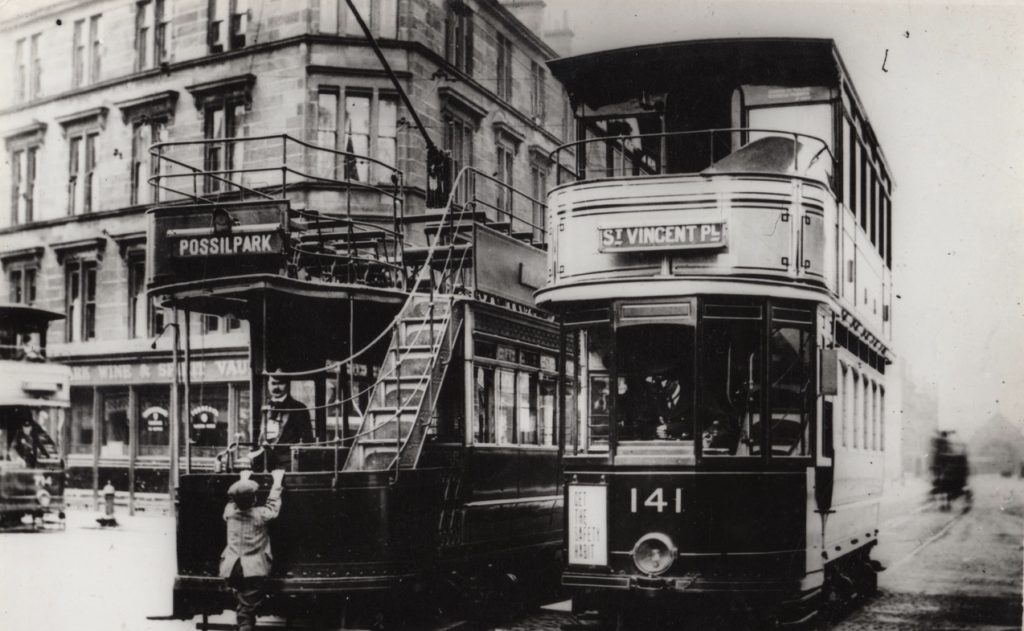
Phase I and Phase III Standard Cars side by side at Saracen Cross, the Possilpark terminus.
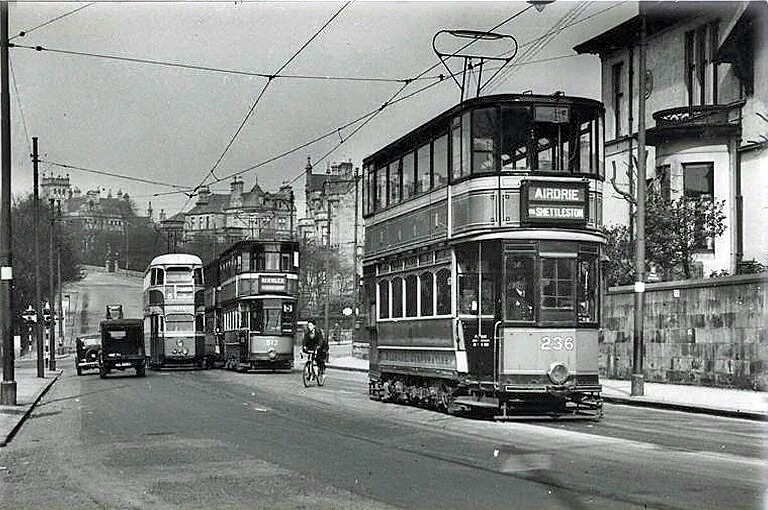
Three fully lined out Standard tramcars and a recently introduced Coronation car are seen here, probably sometime in the first half of 1938, at the Kelvinside terminus situated at the top of Hyndland Road. This photograph was taken before the cross-over at this location was lifted and moved about 200 yards down the road to outside Hyndland Station. The Standard cars seen here are now in Phase IV condition, their balconies having been completely enclosed. As in previous photographs, the trams are in immaculate condition, reflecting the high standard of upkeep by Coplawhill Works and the various tram depots. They would be looking their best in time for the Empire Exhibition which Glasgow was hosting and which would open on 3rd May, 1938 in Bellahouston Park. These tram liveries with route colors and full lining would be the finest that Glasgow’s Standard cars would carry and examples can be seen today on fully restored cars at the Riverside Museum in Glasgow and at the National Tramway Museum at Crich in Derbyshire. ( Original photograph )
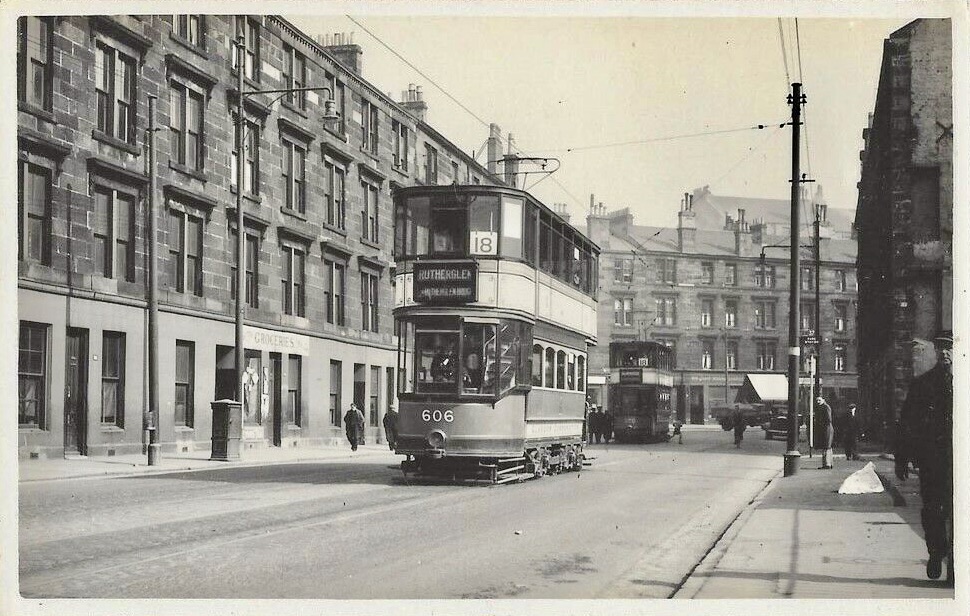
Two white Standard trams in Phase IV condition with their balconies enclosed are seen here in Hawthorn Street, Springburn in 1938. Both trams are now displaying route number 18 printed in black on a white card. Route numbers were introduced on 3rd May 1938 at the opening of the Empire Exhibition and cards were used throughout the system until they were steadily replaced by screens in route number boxes. This photograph is considered to be one of many taken by W.A. Camwell from Birmingham who was a prolific photographer of trams all around the U.K. in the 1930s.
( Information and photograph kindly provided by Hugh MacAulay of the Scottish Tramway and Transport Society. )
Now, you might think that these trams would head off down nearby Springburn Road at the beginning of their return journey to Rutherglen and Burnside but this was not the case. Instead, on route 18, they would travel the full length of Hawthorn Street in the opposite direction, through Possilpark, along Bilsland Drive into Maryhill, down Maryhill Road to St. George’s Road, thence to Charing Cross, Sauchiehall Street, Elmbank Street, then to Bothwell Street, Hope Street, Argyle Street, and east through the Trongate, London Road, Bridgeton Cross, to Main Street, before crossing the Clyde at Rutherglen Bridge and thence to Shawfield, Rutherglen and Burnside. So initially they headed west and then south before turning back east and then south-east.
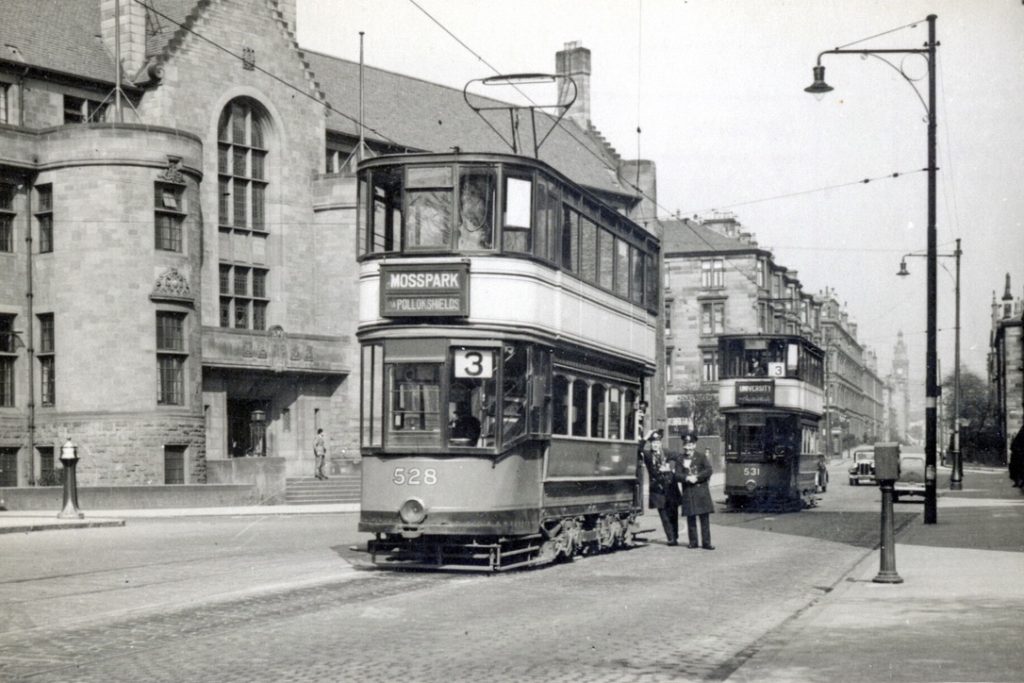
Here are two more white Standard tramcars in Phase IV condition, seen at the University Avenue terminus of Service 3 from Mosspark, most probably in mid-1938. The building across the road was the Men’s Union. At that time, there was only one university in Glasgow, and the male and female students had separate unions. ( Original photograph )
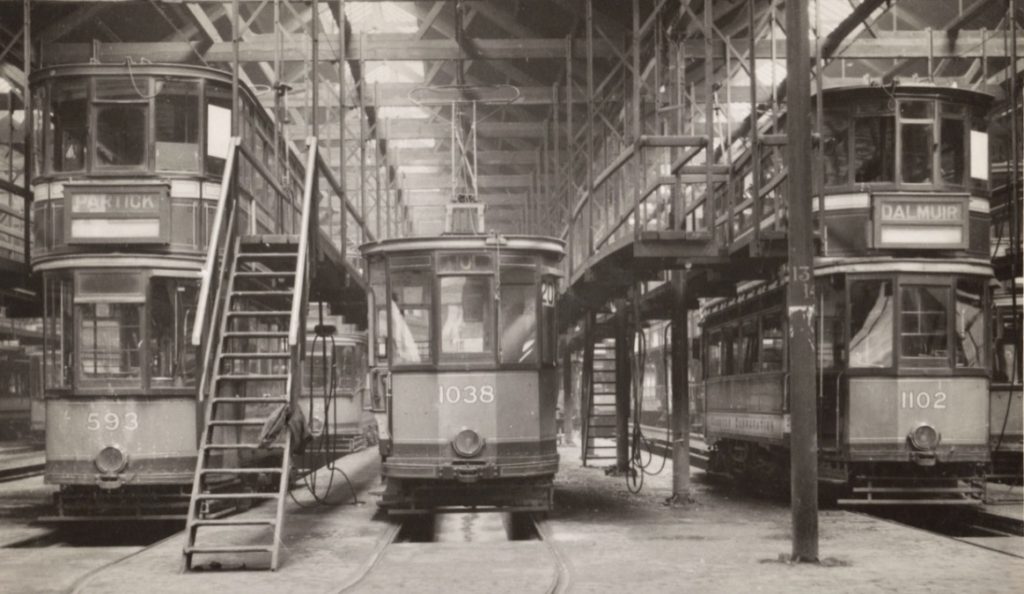
Standard tramcars and a single-deck, converted former Paisley car are seen here in Partick Depot in the 1930’s. The Standard trams are in their lined route colours as this was before route numbers were introduced in 1938. Photograph by W. A. Camwell.
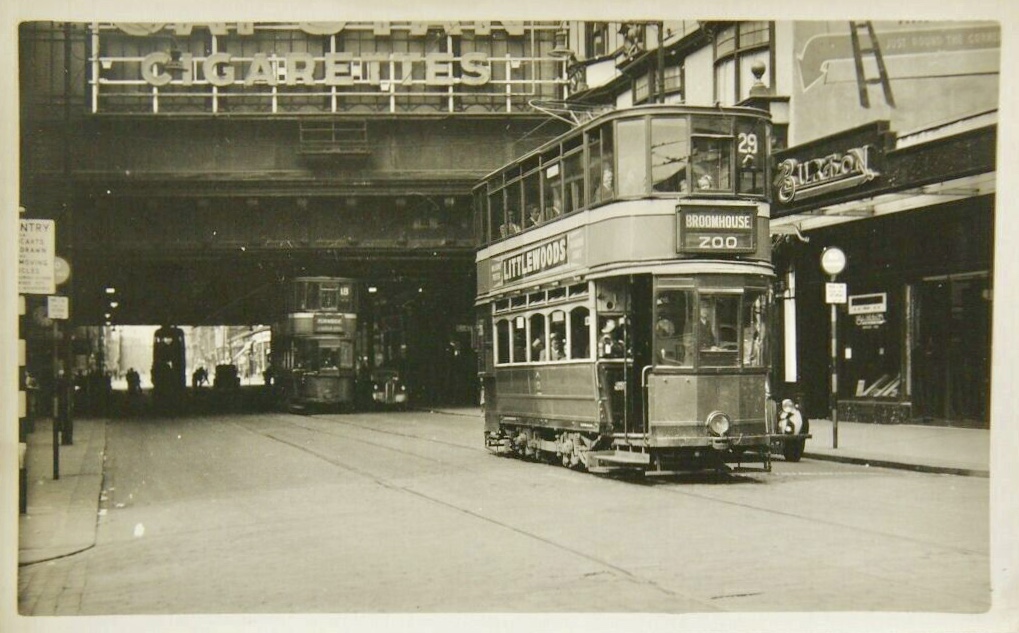
A standard tram operating on service 29 between Milngavie and Broomhouse ( Calderpark Zoo ) is seen heading east on Argyle Street, having just emerged from the Heilanman’s Umbrella on 9th August, 1953. ( Original photograph copyright R. Wiseman.)
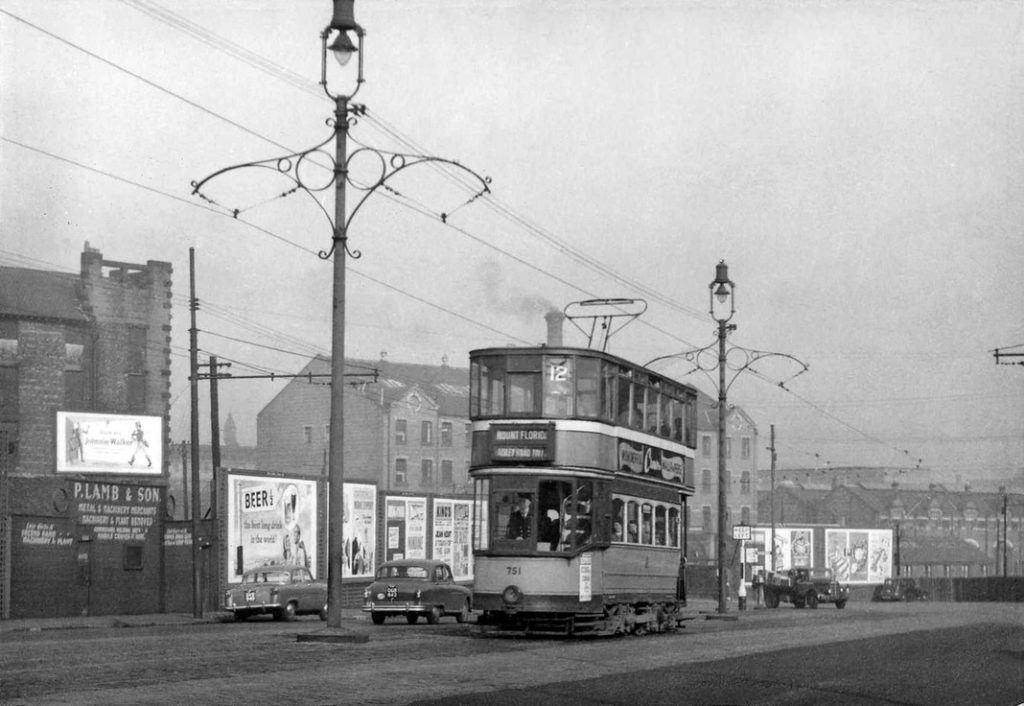
A Standard tramcar on service 12 is coming up Shields Road on its way back to Mount Florida from Paisley Road Toll. Standard cars were used exclusively on this service because their short wheelbase could handle the sharp turns in the track encountered near the Paisley Road Toll terminus. (Photograph reproduced by kind permission of Ian Todd and the Glasgow Chronicles.)
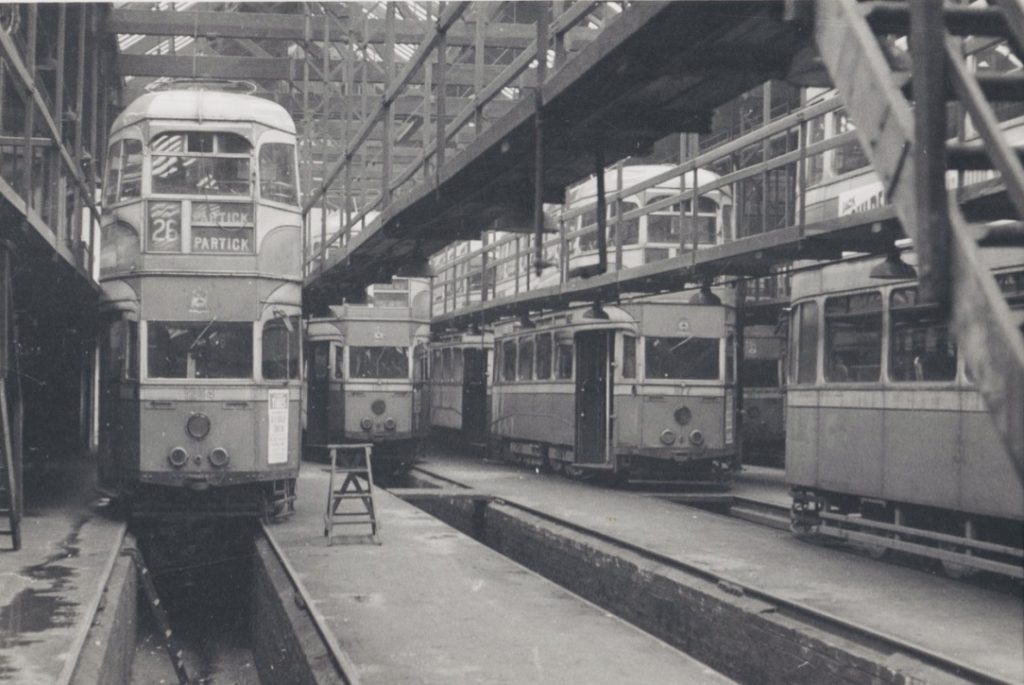
Coronation Mark I cars photographed in Partick Depot on 3rd September, 1961 during an enthusiasts tour.
Please note that all of the photographs here are ones that I have obtained or have permission to use. If any are under copyright, could the owner(s) please contact me and I will request permission to post, and acknowledge them. The text is © Christopher J. Jones.

{ 33 comments… read them below or add one }
My grandfather George Haggerty was a conductor of a Glasgow tram for 35 years. I have photos of him on his tram #565. The name BROOMHOUSE appears on the sign above the conductor’s window.
Gerald
Hi Gerald,
Thank you for sharing this information about your grandfather. During his time as a conductor he would probably have been given the opportunity to train as a driver ( motorman ) if he wanted to. He would certainly have received a long service award. The 15A was the tram service to Broomhouse. It followed the route of the 15 from Paisley as far as Parkhead Cross and then branched off via Tollcross Road and Mount Vernon to Broomhouse and Uddingston.
Best wishes,
Chris
Chris,
Belated thanks for your comments. I’ll try to attached a photo of my grandfather, George Haggerty, who drove a tram for 35 years.
Cheers,
/Users/Ram/Desktop/Broomhouse photo.jpeg
G. G. Haggerty
Hi Chris,
My grandfather was ( I was told) a supervisor at the Shettleston Rd terminus. Name: James Young. Do you have information on this area? I remember the trams as a child and loved them.
Thank you.
Margaret
Hello Gerald,
Thank you for your response. The tram service 15A that ran from Ferguslie, Paisley to Uddingston and called at Broomhouse was certainly operational in 1938 but I have since discovered that a later tram service, number 29, also served Broomhouse and I have posted a photograph taken by R. Wiseman on 7 August 1953, of such a tram heading east on Argyle Street when the service operated between Milngavie and Broomhouse ( at the old Calderpark Zoo ). Between 4 November 1956 and November 1960 the service operated between Maryhill and Broomhouse and then it was curtailed to Tollcross until 21/11/1961 when it was replaced by bus service 61.
Best wishes,
Chris
Hi Chris,
Thank you for assembling this history of Glasgow’s horse-drawn omnibuses and trams, and electricity powered trams. I found it most interesting and I much appreciate your attention to detail, not forgetting to mention the wonderful collection of photographs.
A question that I was seeking to answer remains unresolved and I wonder if you would be so kind as to give it your consideration. A photograph looking north up Buchanan St. with the camera abreast of modern-day Frasers, and labelled 1903, shows a horse-drawn omnibus travelling north. It appears identical to the omnibuses seen in several of your photographs. I understand that Buchanan St. never had trams, horse or electric powered (so no steel rails in the road), but it was obviously served by the horse-drawn omnibus. I can make out “Central Station” on its direction board on the side of the vehicle and it might also show “Dennistoun”. Would you happen to know when that service might have started and, probably more importantly, when it was withdrawn? If the service was operated by the Glasgow Tram and Omnibus Company then presumably it ended with their lease end-date of 30th June, 1894 or perhaps it was taken over and run by Glasgow Corporation Tramways, albeit it was not on rails? Or have I drawn a false conclusion from your text?
Hi David,
Thank you very much for your comment and you are correct in that no Glasgow Corporation Transport Services ran along Buchanan Street. For some reason, it was off limits to public transportation, certainly above ground, except perhaps for taxicabs. The closest that trams and trolleybuses came to the top of Buchanan Street was when they transited between Cowcaddens Street and West Nile Street.
With respect to your photograph, I remember seeing a print featuring a horse-drawn omnibus heading up Buchanan Street. However, this scene must have been prior to 1900 because in the print the tall building on the right-hand side of the street, beyond Prince’s Square, was under construction. The puzzling feature of your photo is the date of 1903. Can you see if the large building beyond Prince’s Square is under construction or is it already complete? If it is absent or under construction, then the photo probably dates from the 1890’s. As for the vehicle, it was probably operated by the Glasgow Tramway and Omnibus Company. After they lost the tramway franchise in mid 1894, they continued to run horse-drawn omnibuses in competition with the Corporation trams but they were fighting a losing battle because the Corporation trams ran much more smoothly and the fares were cheaper. So the question becomes, did the Company ever offer a service that ran along Buchanan Street, in whole or in part? And, at the moment, I don’t know. If the omnibus in your photo is heading for Central Station, then it will most likely be turning left on reaching Gordon Street.
With best wishes,
Chris
Hello Chris,
My apologies, as I know this isn’t a comment/question re trams, but rather Shop Owners of Argyle Street.
I came across a book that I believe belonged to a tailor/shirt maker, James Webster (1817-1867). He had a shop at 86-88 Argyle Street from the late 1850s. I’m wondering if you know who might be a good contact for someone who might have records from the shop? I’m hoping to do a handwriting comparison or to find a matching signature for validity. Thanks in advance.
Abigail
Hi Chris,
My Great Grandfather James Crawford was a tramcar conductor. According to his daughter, he was the first to receive his 45 year long service award. We know very little about him or which routes he operated or even what he looked like. He was born in 1871 and lived in Camlachie.
Thank you.
Jean
Hi Chris,
My mother Mary McSherry worked on the trams. I don’t know the exact date.
Regards, Joe
Hi Joe,
Thanks for sharing this information. Do you know if your mother was a motorwoman or conductress, and the depot/s where she was based?
Best.
Chris
Hi Chris,
I’m trying to find out what tram services ran out of Langside Depot and I’m wondering if you can help me. Thanks.
Ewan Dunlop
Hi Ewan,
That’s a good question. Langside Depot in Battlefield Road may have been the base for trams servicing the following routes in 1938.
Service Number and Route
5: Clarkston – Hillhead, Botanic Gardens, Hyndland
11: Battlefield – Maryhill
12: Mount Florida – Paisley Road Toll, Ibrox Park
13: Mount Florida – Bearsden, Milngavie
19: Netherlee – Springburn
I hope this helps.
Best wishes,
Chris
Hi Chris,
I really enjoyed your article with its well-researched detail and photographs. My questions for you are regarding the horses. How many horses did the Glasgow Corporation have in the heyday of horse drawn omnibuses and then what happened to them after electrification phased them out?
Kind regards
Andy O’Connor
Hi Andy,
I’m glad you enjoyed the report which continues to be a work in progress. According to p. 63 of “The Glasgow Horse Tramways” by Struan J.T. Robertson, when the first 36 electric trams entered service during 1899, there were still 384 horse cars in operation and 4,330 horses on the roster. By mid-1901, there were 439 electric trams in service as well as over 371 horse cars. The system was expanding as well as being electrified and the number of horses on the roster averaged around 4,390. One year later, the horse cars has been completely replaced by electric traction and the stables emptied.
I can only conjecture as to what happened with the horses and I suspect that most, if not all, of those in good health and strength would have been sold off to other enterprises, local and regional, where heavy haulage was required.
Best wishes,
Chris
Hi Chris,
My grandmother, Mary Donnelly, worked out of Langside Depot from what appears to be early 1917 until 1918. She was No. 178 but I do not know whether she was a conductress or a driver. I have a photo of her in her uniform and another with a workmate, M. McDonald but I can’t identify her number. I’m not sure how to attach them for your and others interest. Are you able to advise?
Thanks,
Peter
Hi Peter,
Thank you very much for sharing this information and I will contact you via email regarding attaching the photos.
With best wishes,
Chris
Hi Chris,
My Mum was a Motorwoman from Dennistoun Depot in the early 1950’s – she used to kick my Dad and her brother off for making too much noise!!
She can’t recall the depot number and I would love to find out and try to get her a badge if possible. She is 90 on 11th June 2022!
Lesley
Hi Lesley,
Thank you very much for your inquiry and Happy Birthday to your Mum! She may also have been a conductress on the trams before becoming a Motorwoman. Once I received your message, I contacted the membership of the Scottish Tramway and Transport Society for further information but as yet have nothing to report. I checked on eBay and did not see any Glasgow Corporation Tramway Staff badges listed for sale. I researched Dennistoun Depot in tramway days and found a photo taken inside which I will email to you. If I receive any further information, I will certainly be in touch.
With best wishes,
Chris
Hi Chris,
My mum was born in 1931 and drove a tram in Paisley in the 1950s. Are there any images of lady tram drivers? I know that my mum received several safety award certificates during her time as a driver. Her name was Rubina Graham.
Thank you.
Christine
Hi Christine,
Thank you for sharing this information about your Mum. Yes, there are images of lady tram drivers on this site. In the Chapter, “Glasgow Trams through the Years” there is a photo of a motorwoman in charge of car 914, destination Botanic Gardens. And in the Chapter “Three Glasgow Cooperation Transport Films, 1959-1966”, a motorwoman is featured in the third film, operating a Coronation tramcar on Service 9, Auchenshuggle to Dalmuir West.
Best wishes,
Chris
Dear Chris,
This is a brilliant article. I am trying to find out more about my grandfather, Alexander Blues. He was born 12/02/1895 at 145 Henderson Street and my father was born 08/08/1918 at 39 Springbank Street. On my father’s birth certificate Alexander is described as Tramway Motorman but my father always told me he was more responsible for running the trams. I have a Glasgow Transport 35 years service medallion and what I think is a gold Longine railway monarch special watch. This seems disproportionate to the family finances. Would a driver be expected to have an accurate watch for safety reasons as on the Canadian Pacific Railway or would this indicate a different job?
Best wishes, Clare Blues
Hi Chris,
I am so happy to have found your website during research of my McLachlan ancestry. My relative Charles McLachlan was listed as an Omnibus Conductor in the birth register of his son in December 1850. Then again, in the 1851 census at age 24, he is listed as an Omnibus Guard. He lived at 285 Argyle Street with his wife, sister-in-law, and infant son. He passed away sometime between the 1851 and 1861 census.
Thank you and I look forward to reading your other posts.
Jenny
Hi Jenny,
Thank you very much for your kind message and for sharing information about your Glasgow ancestry. I’m happy to know that you found the information here to be of value in your research.
Best wishes,
Chris
Dear Clare,
Thank you for your comments and for sharing information about your father and grandfather. Springbank Street and the eastern part of Henderson Street are in the Maryhill District. Your grandfather would have trained initially as a conductor for Glasgow Tramways before becoming a motorman. Great Britain declared war on Germany on 4th August, 1914, when your grandfather was 19. By the 2nd of September, 1914 over 1,000 members of the Glasgow Tramways Dept., principally motormen and conductors, had volunteered for active service and they formed the 15th Battalion of the Highland Light Infantry. Perhaps your grandfather was one of them. If so, then fortunately he survived the war and went on to qualify as a motorman. From what your father said, your grandfather may have later been accepted into management. I can understand the award of the long-service medallion. As for the gold watch, he may have received this upon his retirement from management. You may wish to contact the Mitchell Library in Glasgow to inquire if there are service records of Glasgow Tramways staff that may cover the period of employment of your grandfather. The Mitchell Library holds the Glasgow City Archives.
Mitchell Library: Archives open:
Tuesday, Wednesday and Thursday from 10am-4pm and the first Saturday of every month by appointment. To book a research appointment with Archives please email archives@glasgowlife.org.uk or call 0141 287 2910.
Best wishes,
Chris
Hi Chris,
A very interesting article, especially the photographs. I spent my childhood in the 40s & 50s living in Coplaw Street, where the ‘School Car’ ran up and down the street two or three days a week, training the motormen (and women) in the art of tramcar driving. This tram was ex Paisley double decker No 17, which had been cut down to a single deck and given the Glasgow number 1017. It can be seen at present in the Summerlee Heritage Museum at Coatbridge.
Iain
Chris,
An excellent article, thanks for sharing this information.
I have a question for you. I know there were stabling facilities at the Coplawhill tram depot, but I am guessing there would have been many stables and perhaps some pasture land to allow the horses to be ‘rotated’ in and out of service.
Do you know the locations of the various stables in Glasgow, and do you know if there were any stables built to a multi-storey design?
Best Regards,
Russell
Hi Iain,
Thank you very much for your comment and for sharing your early experience living in Coplaw Street. Yes indeed, the “School Car” was a familiar sight there and it is now preserved and operational at Summerlee. Also, you may be aware that GCT Coronation Tram 1245 is being restored there.
Best wishes,
Chris
Hi Andrew,
Thank you very much for your comment and questions. In the days when all Glasgow trams were horse-drawn, there would have been stabling facilities at or very close to all of the depots. When the “Company “ trams were operating, the principal depots and stables were located at Cambridge Street, near Sauchiehall Street, David Street near Crownpoint Street in Calton, Tobago Street near its junction with Great Hamilton Street ( later renamed London Road ), and Nelson Street near Centre Street in the Gorbals. I don’t have any information on multi-storey stables.
All the best,
Chris
Hi Chris,
I just found this website when looking up ancestry stuff. On my grandad’s birth certificate I noticed that the family lived on Hawthorne Street, and my great grandad was a ‘tram depot labourer’. I would make a guess, he probably worked at the nearest depot. Lovely to see photos of the trams and what Hawthorne St. would have looked like when he lived there. 😍
Thank you.
Sinead
Hi Chris,
In your text:- ‘Upset at not having their lease renewed, Andrew Menzies’ Company refused to sell its assets to Glasgow Corporation and so the Tramways Department had to start fresh with new staff, horses, and their own trams while the Company set up in competition’.
If you read SJT Robertson’s excellent book, ‘The Glasgow Horse Tramways’, this theory that the corporation were ‘hard done by’ the ‘Tramway Company’ is pretty much debunked as being propaganda spread by GCT.
The propaganda is still being actively promoted today. Go to the Riverside Museum and the video clip still makes the claim that GCT were the injured party in the ending of the lease.
Andrew
Hi Sinéad,
Thank you for sharing this information and you will be happy to know that Possilpark Tram Depot was located at 240 Hawthorn Street, so this is probably where your great grandad worked.
Best wishes,
Chris
Hi Andrew,
Thank you for your contribution which I approved on reading it and I have since consulted my copy of Struan Robertson’s excellent book. The matter is not clear cut. On page 47 of the book, the steps involved in the sale of the Glasgow Tramway and Omnibus Company’s Govan operation to Glasgow Corporation Tramways are described and this transaction proceeded efficiently and without any dispute or rancor. In addition, the author makes it clear that the Company’s horse cars transferred to Glasgow Corporation in this transaction were in excellent condition and certainly not “fit for the scrap heap” as a quote later attributed to Glasgow Corporation stated. It’s only when we move on to the transfer to the rest of the Company’s Tramway operation to Glasgow Corporation Tramways that the cordiality ends and the transaction becomes very acrimonious indeed, aspects of which as described in Chapter 9.
Best wishes,
Chris